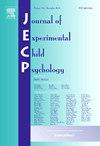The development of letter representations in preschool children is affected by visuomotor integration skills and visual field asymmetries
IF 2
2区 心理学
Q3 PSYCHOLOGY, DEVELOPMENTAL
引用次数: 0
Abstract
One essential skill believed to consolidate during the preschool years is children’s ability to recognize the different letters of the alphabet. The aim of the present study was to track how visual representations of letters change and are consolidated with exposure to print and the graphomotor experience a child has. A secondary goal of this study was to investigate the emergence of the right visual field advantage for letter identification, reflecting children’s sensitivity to the directionality of print. Eighty-one preschool children (aged 4 to 5 years) participated in a longitudinal study where they were shown isolated uppercase letters in both normal upright format and rotated 180°. The letter stimuli were mixed randomly with symbol stimuli in a letter/non-letter lateralized classification task. The results indicated that accuracy in classifying rotated letters as letters—rather than symbols—significantly improved among 4-year-old preschoolers between testing in December (mid-year) and in June (end of the school year). In contrast, little further development was observed in 5-year-old preschoolers, although they still exhibited a slight disadvantage in accuracy when classifying rotated letters. Additionally, behavioral and eye-movement data highlighted a left-to-right deployment of attention by the end of the second year of formal preschool education, evidenced by the emergence of a right visual field advantage. Our results suggest that letter representations undergo significant consolidation during the second year of formal preschool education, which typically corresponds to 4-year-old children in France, with a close relationship between letter identification skills, sensitivity to the directionality of print, and visuo-motor integration skills.
学龄前儿童字母表征的发展受视觉运动整合技能和视野不对称的影响
一项被认为在学龄前得到巩固的基本技能是儿童识别字母表中不同字母的能力。本研究的目的是追踪字母的视觉表现是如何变化的,并与儿童接触印刷物和书写运动经验相结合。本研究的第二个目的是调查字母识别的右视野优势的出现,反映儿童对印刷方向的敏感性。81名学龄前儿童(4至5岁)参加了一项纵向研究,他们被展示了正常直立格式和旋转180°的孤立大写字母。在字母/非字母侧化分类任务中,字母刺激与符号刺激随机混合。结果表明,在12月(学年中期)和6月(学年结束)的测试期间,4岁学龄前儿童将旋转字母分类为字母而不是符号的准确性显著提高。相比之下,在5岁的学龄前儿童中几乎没有进一步的发展,尽管他们在分类旋转字母的准确性方面仍然表现出轻微的劣势。此外,行为和眼球运动数据强调了在正式学前教育的第二年结束时,从左到右的注意力部署,右视野优势的出现证明了这一点。我们的研究结果表明,在正式学前教育的第二年,字母表征经历了显著的巩固,这通常相当于法国的4岁儿童,字母识别技能、对印刷方向的敏感性和视觉-运动整合技能之间存在密切关系。
本文章由计算机程序翻译,如有差异,请以英文原文为准。
求助全文
约1分钟内获得全文
求助全文
来源期刊

Journal of Experimental Child Psychology
Multiple-
CiteScore
4.50
自引率
7.70%
发文量
190
期刊介绍:
The Journal of Experimental Child Psychology is an excellent source of information concerning all aspects of the development of children. It includes empirical psychological research on cognitive, social/emotional, and physical development. In addition, the journal periodically publishes Special Topic issues.
 求助内容:
求助内容: 应助结果提醒方式:
应助结果提醒方式:


